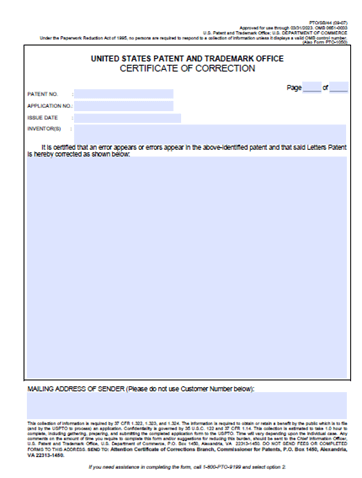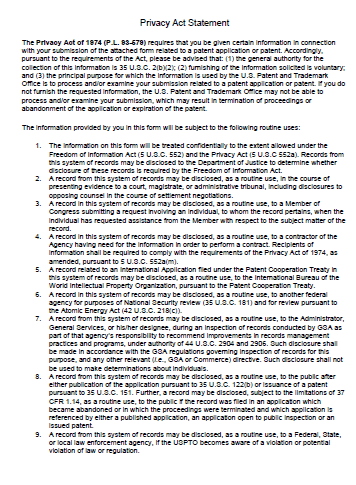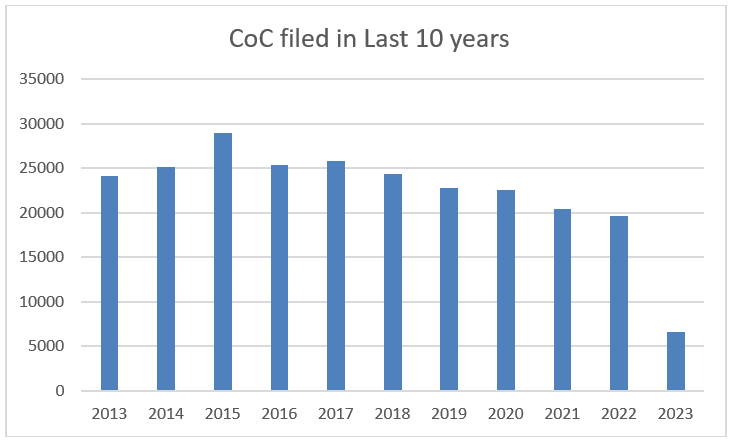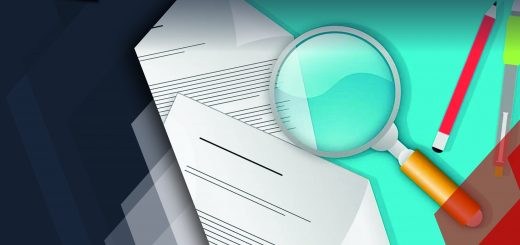The Key Role of Certificate of Correction in Patent Prosecution
In the world of patent prosecution, maintaining the accuracy and integrity of granted patents is of utmost importance for patent owners. One essential tool for patent holders to rectify errors in their granted patents is the Certificate of Correction. This document allows them to make necessary amendments even after the patent has been issued. The Certificate of Correction plays a crucial role in defending against potential infringements by enabling the use of corrected patents to challenge past infringers. It is important to consider that the certificate only addresses minor errors and does not permit significant modifications that would broaden the patent claims.
This article delves into the significance of the Certificate of Correction during the patent application process, exploring its purpose, categories, and the key distinctions between a Certificate of Correction and a Reissued Patent. It also highlights the filing trends and costs associated with Certificate of Correction and much more.
Table of Contents
Overview of Certificate of Correction
A Certificate of Correction is a legal document that rectifies errors in a formerly granted patent by the United States Patent and Trademark Office (USPTO). The certificate aids in correcting mistakes that the USPTO or the applicant made during the patent application process. Once issued, the certificate holds the same effect as if the patent had been granted initially in its correct form.
The USPTO allows applicants to correct three specific types of errors through a Certificate of Correction, namely:
- Errors incurred through the fault of the USPTO,
- Errors made by the applicant, and
- Errors regarding the named inventors.
The patent owner can ensure the accuracy and integrity of their invention by obtaining a Certificate of Correction. This allows them to address and rectify any errors or inconsistencies in the patent, ensuring that it reflects their intended invention precisely.
Categories of Certificate of Correction
There are two categories of the Certificate of Correction:
1. PTO’s Mistake: 35 U.S.C. 254; 37 CFR 1.322
Assume that the records of the Patent and Trademark Office indicate a mistake in a patent. In that case, the Director can issue a Certificate of Correction, which is free of charge, stating the fact and nature of such a mistake. The information will later be entered into the patent records. Alternatively, the Director may issue a corrected patent at no cost, which has the same effect as a Certificate of Correction. Aside from this, the Director can issue a certificate under 35 U.S.C. 254 in the following situation:
- At the request of the patentee or patentee’s assignee.
- Acting on its own initiative for mistakes discovered by the office.
- Relying on third-party information concerning a mistake.
2. Applicant’s Mistake: 35 U.S.C. 255; 37 CFR 1.323
Suppose a clerical/typographical mistake or a minor error appears in a patent, and the mistake occurred in good faith. In that case, the Director may issue a Certificate of Correction upon payment of the required fee. However, if the correction does not entail such changes in the patent, it would constitute a new matter or require re-examination. When the patent becomes coupled with the Certificate of Correction, it has the same legal effect and operation in subsequent trials as if it was initially issued in the corrected form.
PTO may provide a Certificate of Correction under the criteria specified in 35 U.S.C. 255 upon payment of the fee at the request of the patentee or patentee’s assignee. If the patent is involved in a trial or interference before the Patent Trial and Appeal Board, then the request must meet the standards of this section and be supported by a motion under 41.121(a)(2), 41.121(a)(3), or 42.20.


After patent grant, a patentee can file a petition to correct errors considered clerical, typographical, or minor character or apparent mistakes made by the USPTO. To request a published patent correction, the patentee must complete and submit USPTO Form 1050 to the Office of Certificates of Correction. Once the patent office issues the certificate, it holds equivalent legal authority to an initial issuance of the patent in the corrected form.
However, if a Certificate of Correction is not attainable or if the mistake would broaden the scope of the claims, then the patent holder may consider filing a broadening reissue application within two years of the patent’s issuance to address more substantive flaws. The following section delves into the key differences between a Certificate of Correction and a Reissued Patent.
Difference between Certificate of Correction and Reissue Patent
The Certificate of Correction and Reissue Patent are two different mechanisms to rectify mistakes in an issued U.S. patent. Here is a breakdown of their differences:
Certificate of Correction:
- A Certificate of Correction can only correct relatively minor mistakes in an issued U.S. patent.
- The procedures and approval process for obtaining a certificate are typically more favourable to the patentee.
- Minor corrections made through the certificate are more likely to have a retroactive effect against past infringers.
- However, there are limitations to the Certificate of Correction. It cannot be applied to correct a mistake that would broaden the scope of the patent claims.
Reissue Patent:
- If a Certificate of Correction is not attainable or if the mistake involves broadening the scope of the claims, a patent holder may choose to file a broadening reissue application.
- Filing a reissue application will reopen the examination of the patent.
- A reissue application allows the patent holder to address more substantive flaws in the patent, not limited to clerical or typographical errors or minor issues.
The error must identify within two years of the original patent grant to qualify for a reissue patent, and the correction must result in the broadening of a claim.
In summary, a Certificate of Correction is used for minor corrections that do not broaden the claims. At the same time, a Reissue Patent helps with broader corrections, allowing for more substantive changes to the patent.
Cost and Filing Trends of Certificate of Correction
If an error identifies as a mistake made by the USPTO, no fee is applicable for its correction. However, in cases where applicants make mistakes, there is currently a fee of $160 (subject to change) for rectifying such errors, without any reduction for small or micro entities.
The graph below illustrates the trend of Certificate of Correction filings over the past ten years. It provides valuable insights into the filing patterns and activities within this period. Please note that the graph’s data represents accurate information until April 28, 2023.

Guidelines for Certificate of Correction & Importance of Patent Proofreading
To obtain a Certificate of Correction, direct your request to the following address:
Commissioner for Patents,
Office of Data Management Attention: Certificates of Correction Branch,
P.O. Box 1450,
Alexandria, VA 22313-1450
A Certificate of Correction Form PTO/SB/44 is a specialized Form that applicants, or their attorneys or agents, can use for submitting the text of the correction. This form can act as the camera copy for direct offset printing of the Certificate of Correction. The form can also be referred to as Form PTO-1050 and is conveniently accessible for download on the official website of the USPTO.
When only a portion of a request is accepted, or when the office discovers and incorporates further corrections, the office makes the necessary changes on Form PTO/SB/44. The revisions to the Notification of Approval-in-Part Form PTOL-404 are then communicated to the patentee. Approximately six weeks later, the certificate is issued.
The request should clearly state the exact page and line number where the issues occur in the application file. However, on Form PTO/SB/44, only the column and line number from the printed patent should be utilized. To facilitate this process, the applicant must opt for the proofreading service to review their patent application.
Patent proofreading is a crucial procedure that ensures the identification and correction of errors, ultimately ensuring the accuracy of patents, which directly impacts their patent enforceability. This technique is crucial in the patent process as it can be used either as a pre-issuance review to secure a patent or as a post-grant evaluation.
Conclusion
Obtaining a Certificate of Correction is a crucial step in maintaining the accuracy and integrity of a granted patent. This document allows patent owners to rectify any errors made by the USPTO or the applicant during the patent application and grant process. By addressing and rectifying these errors, patent owners can guarantee that their patents accurately depict the intended invention and are safeguarded against potential violations.
It is worth noting that conducting a patent proofreading procedure prior to the grant of the patent holds significant importance. By opting for Sagacious IP’s Patent Proofreading service, applicants can identify errors in a granted patent by cross-examining communication documents stored in the Image File Wrapper of USPTO Public Pair. It prevents future legal implications and saves the attorney’s time and effort.
Additionally, our service offers a comprehensive cross-examination of a granted patent. Our team of highly skilled patent professionals ensures that your application remains flawless throughout the patent granting process. To know more, visit our Patent Proofreading service page.
– Shalini Makhija (IPMS) and the Editorial Team
Having Queries? Contact Us Now!




